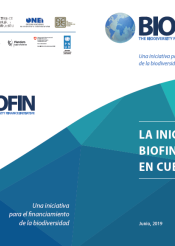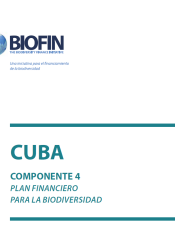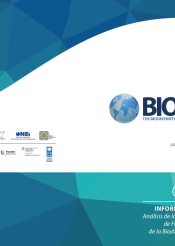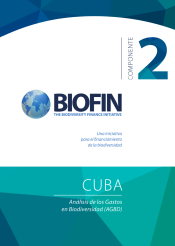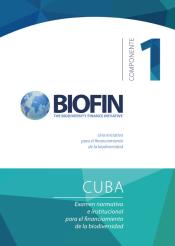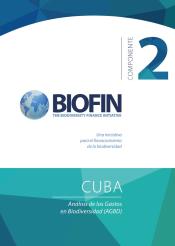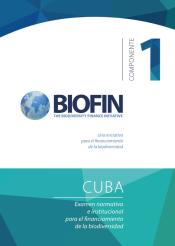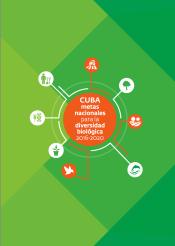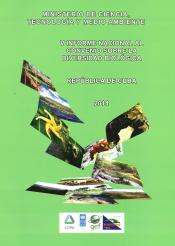Cuba
Cuba, an archipelago located in the Caribbean Sea, is considered one of the four islands with the highest number of plant species worldwide the highest number of taxa per square kilometre. Biodiversity (species, ecosystems, landscapes and genes) is part of the national wealth and natural heritage.
There is a high level of endemism caused by extreme climatic conditions, habitat diversity, geological evolution and geographic isolation. As a result, approximately 50% of plant species and 42% of animal species are endemic.
Coastal marine ecosystems (coral reefs, mangroves and sandy beaches) play an important role in adapting to climate change, which is why they are a priority in Cuba. The mangroves cover a total area of 5647 km2 - the largest in the island countries of the Caribbean. Cuba has a National System of Protected Areas (SNAP) and has 211 identified areas, of the which 77 are of national importance and 134 of local importance that cover 20.20% of the national territory and 17.16% of the total area of the territory.
Cuba joined the BIOFIN initiative in 2016, at a moment coinciding with the start of the National Economic and Social Development Plan until 2030, which includes among its strategic axes Natural Resources and the Environment.
This initiative accompanies the National Program for Biological Diversity (NBSAP) 2016-2020, with emphasis on its goals 3 and 20, related to economic instruments and incentives that contribute to halting the loss of biological diversity and the mobilization of financial resources.
The initiative shows a high synergy with other international projects in which UNDP participates and offers methodological tools that enhance the mobilization of financial resources in support of the implementation of the State Plan for confronting climate change, known as "Life Task", approved by the Council of Ministers in 2017 and that contributes to the achievement of the Sustainable Development Goals (SDG).
BIOFIN, is led in Cuba by the Ministry of Science, Technology and Environment (CITMA), and also integrate National Coordination Group, the Ministry of Finance and Prices (MFP), the Ministry of Economy and Planning (MEP), the National Office of Statistics and Information (ONEI), and the Central Bank of Cuba (BCC).
- Institutional platform consolidated between key ministries of environment, economy and finance. (CITMA, MFP, BCC, MEP, ONEI).
- Approved for the first time in Cuba, a Specific Standard of "Accounting Environmental”, issued by the Ministry of Finance and Prices (MFP), which allows the recording of expenses and income for the conservation and sustainable use of biodiversity and ecosystems.
- Determined for the first time in Cuba, the expenditures on biodiversity (period from 2010 to 2016) amounting to 5,362 million pesos and an average annual expenditure of 766 million.
- Budgeted the 2016-2020 NBSAP, amounting to 1 506 million pesos.
- Determined the financial gap of the NBSAP 2016-2020 in 786 million pesos (52% of the total financing required).
- More than 300 national actors trained with an interdisciplinary approach in biological diversity, economics and finance, through the synergy between BIOFIN and the technical team that formulated the NBSAP 2016-2020.
- Designed a Financial Plan for biodiversity, made up of financial solutions to implement in the short and medium term (until 2025)
1. Entrance fee for protected areas:
BIOFIN, with ECOVALOR project, will try to continue with this financial solution in dialogue with MINTUR. A preliminary calculation of the entrance fee was prepared, which must be recalculated from the process of monetary and exchange unification developed since January 2021. The restrictions on tourism by the Covid-19 have stopped the advance in this solution.
2. PES carbon removal by sustainable forest management
PES carbon removal by sustainable forest management: promotes the conservation of biodiversity based on sustainable forest management practices. The pilot implementation is carried out in the Agroforestry Company of the Matanzas province, as a result of its approval by the Ministry of Agriculture, which directs forestry activity in Cuba.
The certification mechanism is used for the removal of atmospheric CO2 in forests, which requires monitoring the implementation and definition of the procedures required for its operation, establishing differentiated payment rates for the carbon removed in productive and conservation areas, promoting the value of these last. These revenues will support sustainable forest management.
3. Improvement of the National Environment Fund
The general objective of the FNMA Improvement proposal is to redesign the current Fund, modifying its structure, legislation, organization and operation, as well as diversifying its sources and destinations, contemplating the capitalization, profitability and mobilization of resources from other sources, and developing actions that favor better dynamics.
Transformations will be proposed in the organization and composition of the Multisectoral Board that directs the Fund, as well as in its regulations. Also in the dissemination, training, and incorporation of new decision-makers, actors and beneficiaries.
4. Green banking
Development of capacities for the implementation of Green Banking by promoting the financial institutions of the National Banking System, which integrate financial support for the protection, conservation and sustainable use of natural resources, biodiversity and the environment in general; Its mission being to promote a positive environmental impact in financial operations, with emphasis on the search for sustainable sources of financing and their application in projects that demonstrate their effective influence on the goals for adequate environmental management. Together with the above, a project of the SDG Fund with participation and co-financing from BIOFIN is accompanied by the creation of an enabling framework for environmental and climate finance in the country with the establishment of a roadmap and an action plan.
5. Package of financial mechanisms for agrobiodiversity in the non-state sector
It proposes to implement in the non-state sector, an articulated package of mechanisms that mobilize financial resources for the expansion of positive experiences of agrobiodiversity. Ex: ecological labeling, bonus for the rational use of natural resources, tax reduction, agro-tourism, preferential prices for bioproducts and their exportation, among others. Once the pilot is finished, it plans to scale the mechanisms in agro-productive areas with conditions to replicate the experience. This solution is inserted within the priorities for local development, which is promoting the country.
The bases for the National Economic and Social Development Plan until 2030, the National Environmental Strategy, Law 81 on the Environment, and the recently adopted State Plan to Confronting Climate Change in the Republic of Cuba (Task Life) seek to integrate economic and social development into biodiversity conservation and sustainable management.
The finance mechanisms used for biodiversity conservation and sustainable use and the gaps in their operation have been identified. This has highlighted the need to get them improved to optimize their implementation as well as that of new finance mechanisms.
The major difficulties for the implementation of economic mechanisms are identified in the institutional framework. There is a need to build capacities that ensure the systematic implementation of the policies that have been adopted.
The most outstanding recommendations include:
-
reviewing and updating the legal framework, involving new stakeholders to move toward diversified sources of biodiversity finance;
-
ensuring that the Ministry of Finance and Prices implements accounting standards that identify biodiversity income and expenditure and make it possible to establish other finance mechanisms; and
-
promoting the design, implementation and evaluation of mechanisms that enable to redistribute and use biodiversity-generated income in conservation and/or management activities, among others.
The BIOFIN initiative has developed its work while closely supporting the National Biodiversity Strategy and Action Plan (NBSAP) and its Plan of Action for 2016-2020. The direct interrelation with the national experts who formulated NBSAP and the training of a large group of experts on the process to identify biodiversity-related actions are some of the unique features of the Cuban experience.
Prepared for BIOFIN key stakeholders, the “Training Manual on Biological Diversity” facilitates the identification of biodiversity expenditure.
The analysis that has been conducted showed that total biodiversity expenditure in the 2010-2016 period had exceeded 5,362 millions pesos (MMP), with an average annual expenditure of 766 million. Implementation in 2016 was 2.8 times higher than that of 2010.
The agencies with the highest volumes of expenditure included the Ministry of Agriculture (68 per cent), the Ministry of Higher Education (10 per cent), and the Ministry of Science, Technology and Environment (7 per cent).
Considering BIOFIN categories, 43 per cent of expenditure goes to restoration; 19 per cent, to awareness-raising and knowledge generation; and 10 per cent, to protected areas and conservation measures.
Biodiversity finance needs were identified through results-based budgeting for the 20 goals under the National Biodiversity Strategy and Action Plan (NBSAP) for 2016 -2020.
A methodology was prepared to help stakeholders identify the information necessary to budget NBSAP action results for the first time in the country. This methodological tool will be used to budget future biodiversity goals.
The permanent interrelation between BIOFIN and NBSAP implementers in the 2016-2020 period has made it possible to exchange information and develop the Sixth Report to the Convention on Biological Diversity (CBD).
The total budgeted expenditure for NBSAP implementation (2016-2020) amounted to 1,506 million pesos, with 719 million in financing and 786 million in identified gap.
Based on the results obtained, a mapping tool that includes the 20 goals under NBSAP and its financing gaps was developed. The finance solutions devised for Cuba according to the BIOFIN Catalogue were also identified. The process involved the consideration of the feasibility of implementing such solutions.
The Finance Plan includes a number of finance solutions that can be implemented in Cuba to mobilize resources for biodiversity conservation and sustainable use, while minimizing the existing gap level.
In Cuba, the State Budget is the main source of biodiversity finance, complemented mostly by national funds and national and international projects.
The Finance Plan foresees a gradual increase in income due to the progressive incorporation of finance solutions from 2019 to 2030.
Efforts are currently underway to articulate finance solutions into various time horizons, considering in the short term those that require no significant modifications in the legal and institutional frameworks and can therefore see a speedy implementation.
